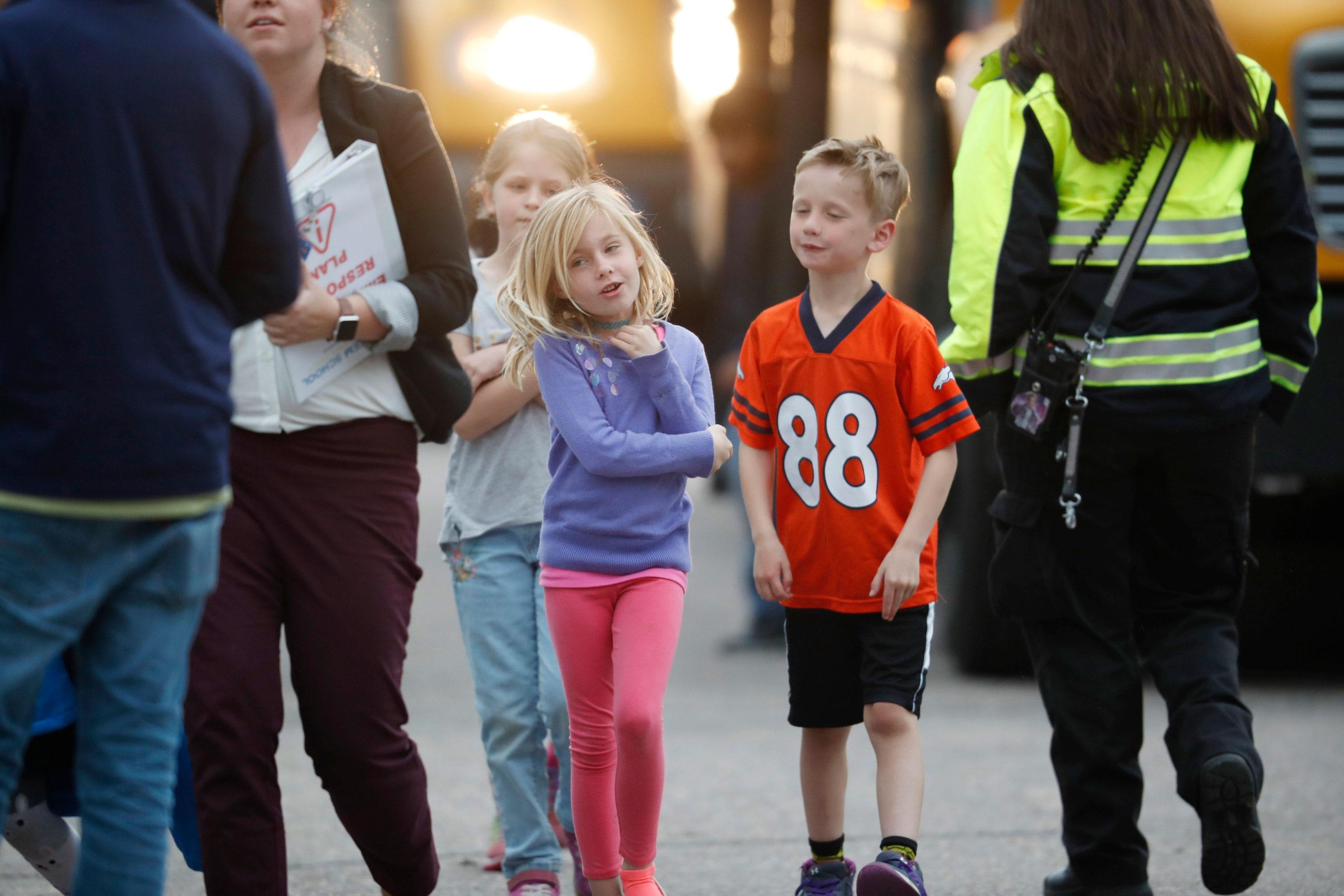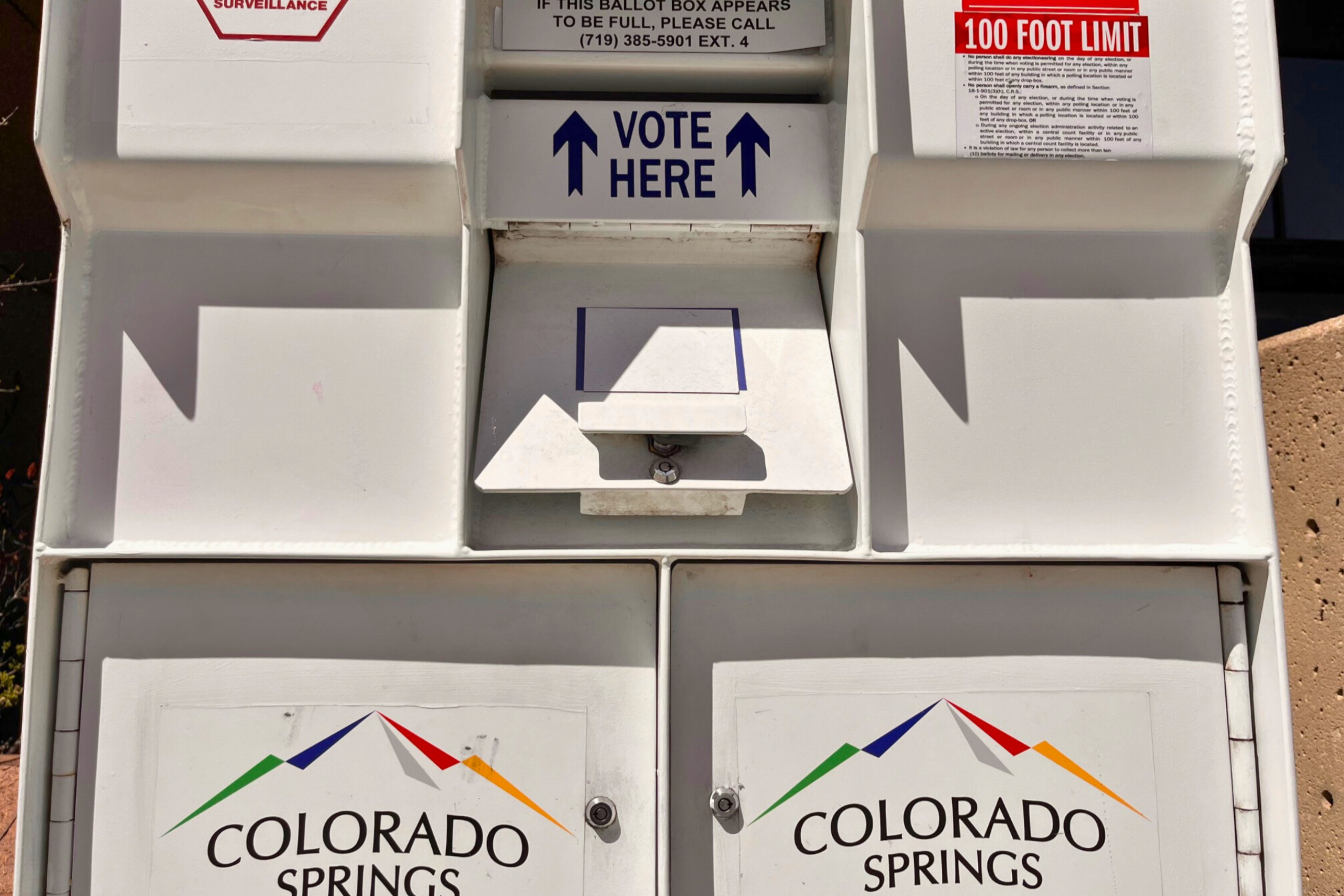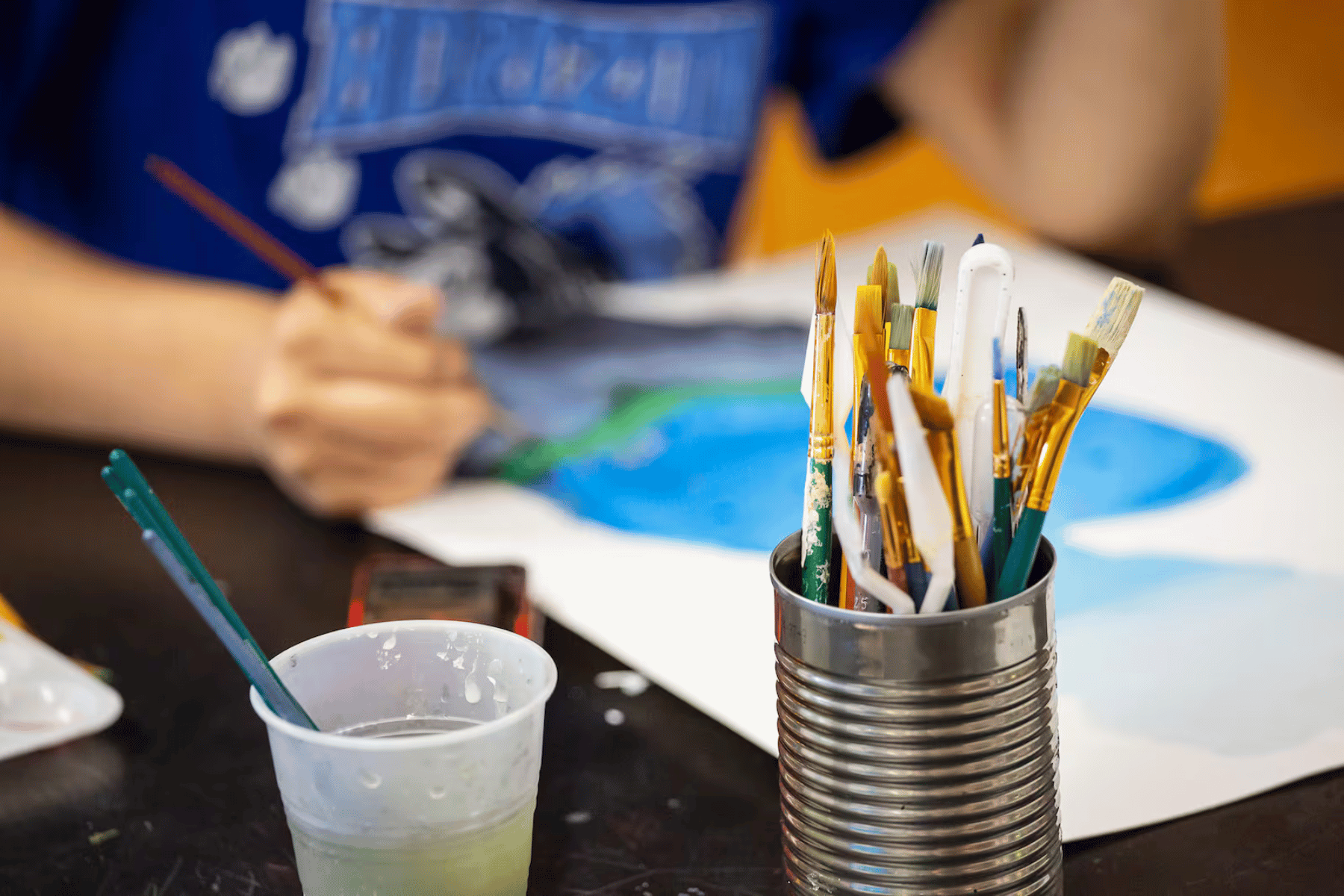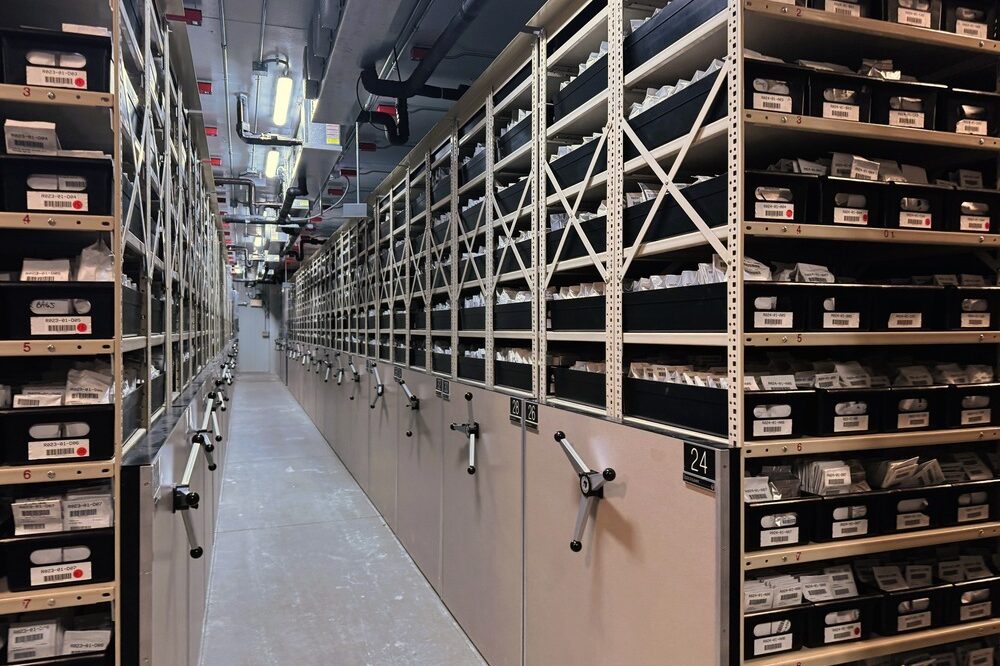

“I can’t reach my siblings.”
Fourteen-year-old Tyler Sayre texted his mom, dad and grandparents from the quiet of his eighth-grade language arts classroom. He and fellow students huddled together in the back corner of the room as they’d practiced.
Just like the school lockdown drills he has practiced dozens of times before, a loud and commanding voice repeated itself over the intercom system at STEM School Highlands Ranch.
“Attention, please. Lockdown. Lock, lights, out of sight.”
But the announcement didn’t stop. That’s when Sayre knew something was wrong.
“Then we hear yelling in the halls,” he said. “And then maybe 10 or 20 minutes in, we hear the first gunshots. And then lots of banging and yelling, and sirens outside.”
He feared for his two younger brothers and one younger sister, who also go to STEM. He said the drills had prepared him for the mechanics of the moment, but not for the reality of an active shooter situation.
Police say two fellow students attacked the school that day, killing 18-year-old Kendrick Castillo and injuring more — but most in the building wouldn’t know that for hours. For many, there were only questions.
“What if they got into our room, what would we do?” Sayre said. He felt helpless to defend himself.
In the silence, he and the others needed to know what was going on. Sayre checked Twitter and saw the updates from the Douglas County Sheriff. “Unstable situation, shots fired at STEM school at Ridgeline and Plaza. Avoid area.” His phone was passed around in the quiet.
That’s when the group started to text their parents.
He said kids without cell phones were borrowing from friends to let loved ones know they were OK for now. Sayre wouldn’t be reunited with his siblings until hours later.
The eighth-grader said he’s thinking a lot about what comes next, now that he’s part of a “growing statistic of school shootings.” He wonders what lockdown drills will be like for him and his friends in the future.

“Anytime we hear that drill, we’re going to immediately remember the situation, and then start going to like that fight or flight situation,” he said. “I’d think, ‘Where is the closest thing we can grab, and what we can use to defend ourselves?’”
Sayre didn’t get much sleep the next night, and neither did his friends.
“I think everyone is really just in shock, more or less feeling like, ‘Oh my gosh this just happened. To our school,’” he said.
“I’m worried about your kids.”
Irma Persoff received that text message on her way over to pick up her boys from the high school part of the STEM building. She was a little early. Confused, Irma tried calling the school a few times with no luck, so she sped towards the building. When she got there, she could hear the lockout announcement blaring from inside.
“I could see SWAT teams in full tactical gear, behind trees with rifles pointed at my babies’ school,” she said. “That was something that I don't think I will ever be able to forget.”
Her sons Kieran and Malokai, a sophomore and a junior, were hiding in separate rooms inside the building.
“When it began, our teacher said something along the lines of, ‘I don’t know if this is real or fake,’” Kieran said. That put him on edge. After the lockdown announcement didn’t stop, he checked his phone. He got a text from his father that read, “What’s going on? Are you OK?”
“That was probably the most surreal part,” Kieran said.
His mind started to swirl. It was hard to think. He started to plan for what he would do if a shooter were to enter his room.
It didn’t take long for Malokai to understand it wasn’t a drill.
“Then we saw police lights through the window, and we just knew that it was real,” Malokai said. “It was really shocking.”
He said the situation was surreal. He experienced an odd sense of calm, which he attributed to the adrenaline. Like Sayre, Malokai said he was prepared to do what he needed to do physically during the lockdown, but he wasn’t ready for what he went through emotionally.
“I think that it became so much more horrifying to me when we walked out of the middle school entrance, and we had to walk over broken glass because (the SWAT team) had to break their way in.”
Outside, Irma was struggling, too.
“A lot of parents started to go closer, and some of the SWAT members started to push back and let them know this is not safe, the situation is not yet under control, you need to back up,” she said.
She started to hyperventilate and realized she needed to do something instead of just watch the scene unfold. As parents arrived on the scene, she started to direct them away from the school and told them where to go.

Jason Persoff, the boys’ father, had been asleep. He works nights at the University of Colorado Hospital as an associate professor and assistant director of emergency preparedness.
His phone rang several times, waking him, and he picked up. It was Irma. She was screaming, and Jason could hear sirens behind her.
“I remember thinking, OK, OK. All right. This isn't happening. It's going to be okay.”
His background in emergency preparedness had taught him that most shootings end within less than 10 minutes.
He texted his sons. He heard from Malokai right away. It took longer to hear from Kieran. Once he did, Jason was relieved.
He was hopeful his kids would be OK.
“But at the same time, I realized my kids were still locked in that school. And I couldn’t get there,” Jason said. “I’m stuck at home, and I can’t do a damn thing. I didn’t know how to react.”
Hours later, reunited with their children and holding them tight, Jason and Irma cried.
“I think that they were a lot more scared than we were,” Malokai said. “Because we were more in shock I guess.”
Irma agreed.
“We've never had these drills, and we don't know what our children actually know,” she said. “Maybe it would be a good idea to have an open drill house? Let’s see what our kids know.”
Irma says in the conversations since the shooting, she’s learned a lot about what her sons had done to prepare for that moment.
“Not knowing those things, it's terrifying. It's really terrifying to know that your child is in that building with a true threat.”
Kieran said the shooting showed him that lockdown practices have worked, and he’s glad to have done them. Jason and Irma are thankful as well and are glad that lessons from Columbine and other school shootings might have kept their kids safe.
The younger kids in the building didn’t have cell phones.
Rebecca Vega’s sons Oliver and Xavier, 8 and 10 years old, were both in the elementary wing. When Rebecca realized what was happening at the school, there wasn’t a way for her to check on her boys.
“That made it that much more scary,” she said.
She was already on her way to pick up her kids when she received notice that the school was on lockdown and that parents were to stay away from the building. She was directed to the Northridge Recreation Center where she met up with her sister, who also has kids at STEM.
Vega felt frantic to get to where she needed to be to see if her kids were OK.
“It was really hard looking into the eyes of all those parents whose faces were mirroring mine, with terror and fear and sadness at the whole situation,” Vega said.
She was first reunited with her youngest son, Oliver, outside the building. The two of them then went inside to find Xavier, where Oliver spotted him first.
Vega was with overcome with emotion and thanked every teacher she saw.
“I know that that must have been just as terrifying for them,” Vega said. “And to remain calm, and follow procedure to ensure that they got all of the students out as safe as possible. It was just a very overwhelming experience.”
On the car ride home, her sons started to tell her what happened. They said at first it seemed like a normal drill. They played rock paper scissors with friends. One son briefly fell asleep.
But then things got scary. As the SWAT team got closer, they could hear yelling and banging. Then they broke down the door.
“It was very surreal to hear my 8-year-old describe that in such a way that made it seem like he was telling me what he had for dinner the night before,” Vega said. “I find that very sad because they are trained for this. They're prepared.”
She plans to talk to her boys before they return to school and before they have to practice another drill. She wants them to understand what they might experience — flashbacks, fear and other emotions now that it isn’t pretend for them anymore.
Later, Rebecca got an email from Xavier’s teacher, saying the kids were “phenomenal. They were respectful. They listened and they were so proud of them because they didn't panic.”
“It was amazing and heartbreaking at how efficient and wonderful everything worked,” Vega said.
Malokai said students had only drilled for the lockdown, not for the evacuation.
He knew to put his hands in the air when the SWAT team broke down the door, guns pointed directly at him and his classmates. What came after was new.
“I guess now I'll be more prepared if that happens again,” Malokai said.









